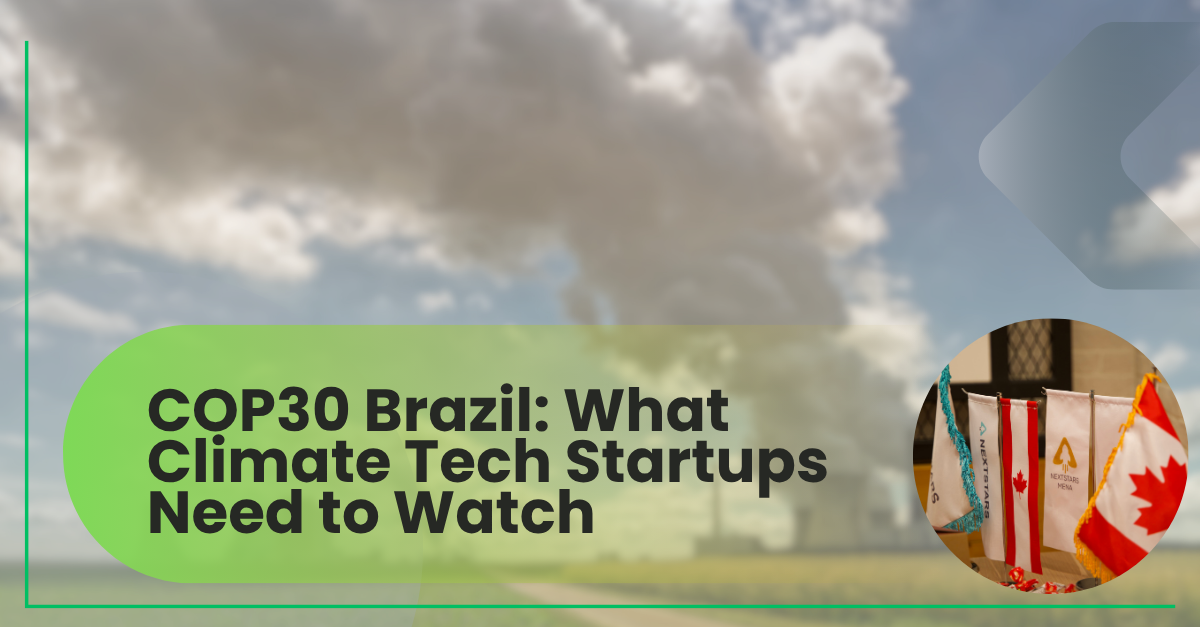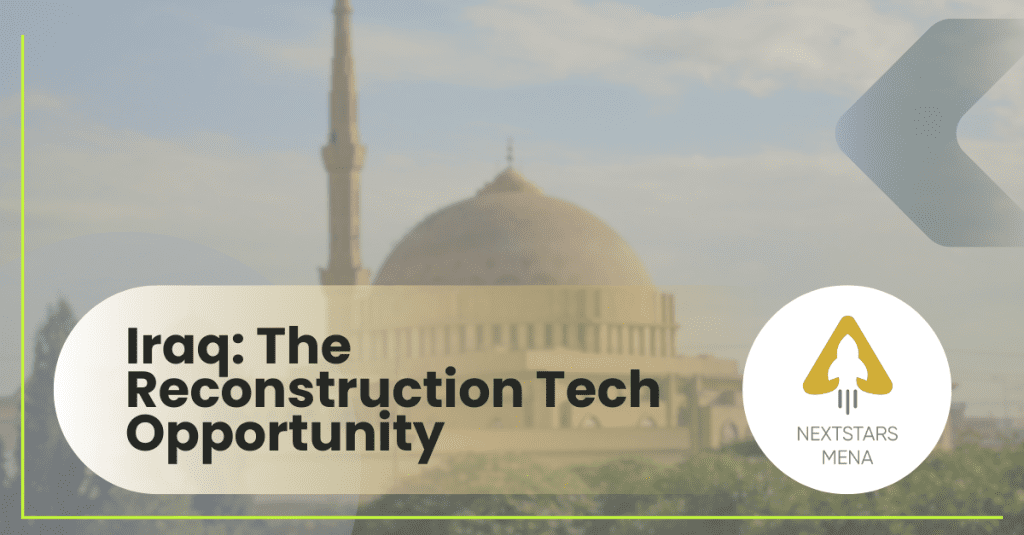November 10-21, 2025 | Belém, Brazil
As the world gathers in the heart of the Amazon for COP30, climate tech startups have a unique opportunity to position themselves at the intersection of global policy, capital flows, and emerging market opportunities. This isn’t just another climate conference—it’s a pivotal moment that will shape the next decade of climate investment and innovation.
Here’s your strategic guide to what matters most.
Why COP30 Matters for Your Startup
COP30 arrives at a critical inflection point. The conference marks 10 years since the Paris Agreement, and countries are submitting their third Nationally Determined Contributions (NDCs 3.0). More importantly for startups, the “Baku to Belém Roadmap” aims to scale international climate finance from $300 billion to $1.3 trillion by 2035.
Translation for founders: This represents one of the largest planned reallocations of capital in history, and understanding where that money flows will determine which climate tech categories explode over the next 5-10 years.
Key Themes to Track
1. The $1.3 Trillion Question: Climate Finance Architecture
The biggest story coming out of COP30 will be how nations plan to bridge the massive gap between the $300 billion committed at COP29 and the $1.3 trillion target. Watch for:
- Blended finance mechanisms that combine public and private capital
- New carbon market structures following Brazil’s proposed Climate Coalition
- The Tropical Forest Forever Facility – a $125 billion fund launching at COP30 to reward forest conservation
Startup Takeaway: If your solution can demonstrate carbon impact, forest preservation, or ties into emerging carbon credit markets, understand how to position for these new funding mechanisms. Brazil’s proposed border carbon adjustment could create entirely new compliance markets.
2. Buildings & Cooling: A 40% Emissions Opportunity
The Buildings and Cooling Pavilion in the Blue Zone (endorsed by Brazil’s Ministry of Cities) will spotlight solutions addressing the sector responsible for nearly 40% of global emissions. This includes:
- Energy-efficient building design and retrofit solutions
- Sustainable cooling technologies (increasingly critical as climate adaptation)
- Low-carbon materials and circular construction
Startup Takeaway: If you’re building in PropTech, construction tech, or sustainable materials, this is your sector’s moment. The first Intergovernmental Council for Buildings and Climate Ministerial Meeting happens at COP30.
3. The AI-Climate Convergence
A significant trend for 2025: AI is consuming 53% of global VC dollars, but climate startups are increasingly partnering with or pivoting to address data center energy demands. Data centers now consume up to 4% of global electricity, creating fresh opportunities in:
- Energy efficiency technology for computational infrastructure
- Grid optimization and energy storage
- AI-powered climate modeling and carbon tracking
Startup Takeaway: If you can position at the intersection of AI infrastructure and climate solutions, you’re in a sweet spot for crossover investment.
What to Watch: Pre-COP and Side Events
Pre-COP Business Forums (São Paulo, November 5-6)
Due to accommodation challenges in Belém, major business and finance events are happening in São Paulo before the main conference. The “COP30 Business and Finance Forum” will host key decision-makers including:
- Ana Toni (COP30 CEO)
- Dan Ioschpe (Climate High-Level Champion and industrial leader)
- Major investors and development finance institutions
Why It Matters: This is where capital allocation discussions happen before they become policy. If you can’t get Blue Zone access, São Paulo pre-COP events offer valuable networking without the $9,320/night Belém accommodation crisis.
Blue Zone Pavilions and Side Events
The Blue Zone hosts 100-150 pavilions from countries, organizations, and sectors. Key pavilions to follow:
- Brazil’s Official Pavilion – showcasing Amazon-focused solutions
- Buildings and Cooling Pavilion – sector-specific programming
- Nordic Pavilion – focused on international cooperation in climate action
- National pavilions from major economies – watch for partnership announcements
Access Note: Blue Zone requires UNFCCC accreditation. Many pavilions livestream sessions, so you can participate remotely.
The Climate Action House (November 10-14)
An independent event outside the Blue Zone designed for business, policy, and finance collaboration. More accessible than Blue Zone and focused on driving the “COP30 Action Agenda” through networking and innovation showcasing.
What VCs Are Looking For in 2025
If COP30 accelerates your fundraising plans, here’s what climate tech investors are prioritizing:
The Current Reality
- Q2 2025 funding dipped 50% to $5.9B, hitting multi-year lows
- Policy uncertainty is the #1 investor concern (50% cite regulatory risk)
- VCs are favoring later-stage, proven technologies with clear paths to revenue
- The bar for traction is higher – especially for hard tech requiring IP, infrastructure, or regulation
What Gets Funded
According to recent investor surveys, climate tech VCs are looking for:
- Clear problem framing with global stakes – numbers over adjectives
- Novel technology that incumbents can’t replicate – brutal honesty about what’s proven vs. theory
- Vertical market breakdown – who pays? What’s regulated? Offtaker pipeline?
- Transparent business models – where money comes from, capital flows, CapEx spikes
- Measurable environmental impact AND financial viability
Hot Sectors for Investment
- Carbon capture and sequestration – particularly for hard-to-abate industries
- Long-duration energy storage – beyond traditional batteries
- Sustainable agriculture and food systems
- AI-driven climate analytics and optimization
- Climate adaptation infrastructure (not just mitigation)
Practical Actions for Startups
If You’re Attending COP30
- Book accommodation NOW through official channels (cop30.bnetwork.com) or consider cruise ship options at Port of Outeiro
- Target pre-COP São Paulo events for investor access without Belém pricing
- Secure Blue Zone accreditation early if applicable to your stakeholder status
- Schedule meetings in advance – don’t expect spontaneous networking in this environment
- Prepare for themed daily programming aligned with COP30 Presidency agenda
If You’re Following Remotely
- Watch UNFCCC YouTube livestreams for major plenary sessions
- Track pavilion programming – many sessions are streamed and recorded
- Monitor announcement of new funding mechanisms and partnership frameworks
- Follow #COP30 and sector-specific hashtags for real-time insights
- Join virtual side events through organizations like Climate Action Network
For Fundraising Post-COP30
- Update your pitch deck with any new policy frameworks or funding mechanisms announced
- Demonstrate alignment with NDC 3.0 priorities from major economies
- Quantify your solution’s fit with the $1.3T climate finance roadmap
- Highlight regulatory readiness – policy uncertainty is top investor concern
- Show both environmental impact metrics AND financial viability – dual mandate is non-negotiable
The Belém Context: Why Location Matters
COP30 is the first UN climate conference held in an Amazon state, creating unique opportunities for solutions focused on:
- Forest conservation and restoration (Brazil’s signature initiative)
- Nature-based climate solutions
- Biodiversity protection alongside carbon reduction
- Indigenous knowledge and community-led approaches
- Tropical climate resilience and adaptation
Brazil’s leadership under President Lula has made Amazon protection central to the global climate agenda. Solutions that support this priority while delivering economic value for tropical countries will likely see significant attention and potential funding.
Looking Ahead: The Post-COP30 Landscape
For early-stage climate tech startups:
- First funding rounds have outperformed the overall VC ecosystem since 2019
- Early-stage activity signals a strong pipeline despite later-stage funding challenges
- The “commercial-ready” gap ($45-100M scale projects) remains hard to fund
Key trend: Climate tech isn’t a niche anymore. Every sector—energy, SaaS, agriculture, fintech, mobility, manufacturing—has a climate dimension. Corporate sustainability targets and government mandates are creating pull-through demand.
The challenge: Fewer VCs are participating beyond Series B compared to 2021. If you’re pre-seed or seed stage, build with capital efficiency and clear milestones toward commercial readiness.
Final Thoughts
COP30 represents a moment of reckoning for global climate ambition. For climate tech startups, it’s a forcing function that will clarify:
- Where the next decade of climate capital will flow
- Which technologies governments will prioritize in NDC 3.0
- How policy uncertainty will be addressed (or not)
- Which partnerships between public, private, and philanthropic sectors will unlock scale
Your job isn’t to attend every session or secure every meeting. It’s to understand the emerging framework of climate action and capital allocation—then position your startup at the intersection of global ambition and commercial viability.
The startups that will thrive post-COP30 are those that can translate policy commitments into market opportunities, demonstrate both climate impact and financial returns, and build solutions that don’t just address climate change but make economic sense without subsidy dependence.
Stay Connected: Follow our COP30 coverage series for ongoing analysis of key announcements, funding mechanisms, and startup opportunities emerging from Belém.
Questions? Insights from COP30? Share your thoughts with the NextStars community.





